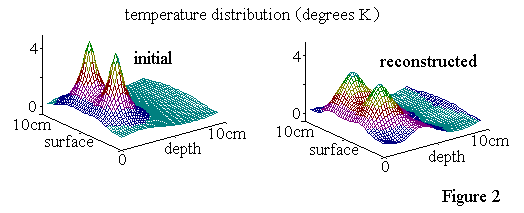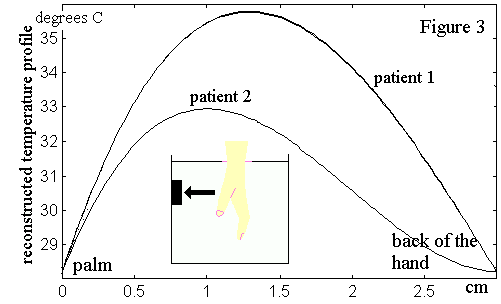Victor I. Passechnik - passechn@bfhome.msk.ru
Andrej A. Anosov, Konstantin M. Bograchev
ELDIS IRE RAS, Starosadskiy per.,8
Moscow, Russia, 101 000
Popular version of paper 4aBB7
Presented Thursday morning, March 18, 1999
ASA/EAA/DAGA '99 Meeting, Berlin, Germany
It is well known that a medical examination usually begins with the doctor using a stethoscope to listen to the patient's heart and lungs . The doctor's examination occurs at the surface of the bodyand detects changes in the sound radiating from internal organs. Such non-invasive measurements are absolutely harmless to the patient.
The doctor hears acoustic signals with frequency about 1000 Hz. But what is possible "to hear" at frequencies about 1,000,000 Hz? If one uses modern, high-sensitivity sensors, it is possible to measure at the molecular level. The chaotic movement of each molecule is determined by the temperature of the given area. By measuring the acoustic radiation induced by this movement, it is possible to determine the temperature. Thus, by registering the signal from a specific area within the body, we can determine the temperature of the area. Measuring temperature or temperature changes within body parts is an essential aspect of many cancer treatments applied to organs such as the liver, breast and prostate. During these treatments it is important that the tissues surrounding the diseased organ are not damaged. One method of heating such tissues is by the use of high intensity, focussed ultrasound. During this procedure it is necessary to maintain the optimum temperature in the heated tissue. At present, temperature measurements of he treated tissues are made by implanting micro-thermometers using needles, which is a painful and distressing procedure for the patient. Cancer treatment would be very much improved if non-invasive methods for measuring temperature could be used. We are developing a method to measure body temperature changes that we believe could be used to overcome this problem. Instead of penetrating the body with a micro-thermometer, we propose to use a thin beam of acoustic radiation generated by the human body itself. When micro-thermometers are used we know the precise point and depth in the body where the temperature is being measured. An alternative non-invasive method, such as passive acoustic tomography, must also be able to achieve this level of precision. Unlike known active tomographic methods (for example, active ultrasonic tomography, x-ray computer tomography, etc.) which both sense and emit radiation, passive acoustic tomography only senses radiation.

As an example of how the method works we can consider a model system. Figure 1 illustrates the medium being studied (for example, a part of a human body) and the area within the medium where the temperature will be determined. The receivers of the thermal acoustic radiation are located on the surface of the medium. Each receiver can be turned at a range of angles to allow the measurement of acoustic radiation coming from different points within the medium. Using this method we can obtain a set of measuremen s from which we can reconstruct the distribution of the internal temperature. In order to reconstruct the temperature distribution we have developed some specific mathematical algorithms, which have been checked using computer simulation.

Figure 2 shows the reconstruction of the stationary internal temperature of the human body during heating with two heat sources of equal intensity located at some distance from each other. Figure 2 shows the initial and reconstructed temperature distributions in the body, obtained by the computer simulation of the method. This stimulation was carried out taking into account the blood flow inside the human body. We have reconstructed with acceptable precision the temperature of a 'phantom', which has acoustic properties that are similar to those of the soft tissues within the human body. The method that we have developed has allowed us to reconstruct the temperature distribution within a human hand immersed in a tank of water (Figure 3).

The temperature of the skin was the same as the temperature of the surrounding water. The maximum value for the internal temperature measured within the hand was about 33-35 degrees C. In conclusion, our experiments and calculations indicate that it is possible to reconstruct the internal temperature of an organism using our non-invasive and painless method.